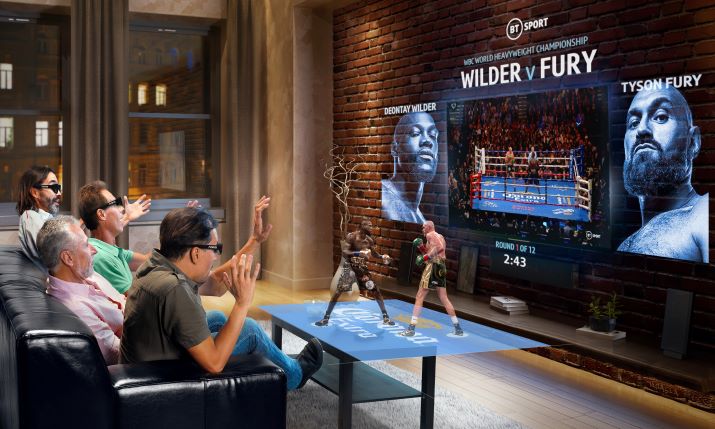Op ed focus: Looking at the limitless opportunities of 5G for the sports broadcasting industry

Boxing with a 3D AR version of the match on your coffee table could become a reality with the 5G Create project, 5G Edge-XR, the consortium led by BT’s Media and Research teams, which will enable people to view immersive sporting events from all angles, across a broad range of devices
Sports broadcasting is a unique and exciting industry, bursting with opportunities for those interested in technology. While broadcasters are, as a rule, a cautious bunch – you can’t afford to upset the fan watching a live game at any cost – the competitive nature of sports broadcasting in the pursuit of pay-TV subscribers has pushed technological innovation to the fore in recent years, enabling rights holders to give viewers at home ever more engaging, exciting and addictive live television.
The COVID-19 pandemic accelerated the rollout of 5G networks, as telcos responded to the spiking demand for ultrafast broadband connectivity. Data and research provider, the IABM, says that global 5G network infrastructure revenue is estimated to grow by 39% year on year, reaching over $19 billion in 2021.
While consumers were at the heart of this demand – working from home, streaming video content, and gaming – the sports broadcasting industry has been testing businesses cases for 5G connectivity in the production of live sport, quite a while before the rest of the world was trapped at home.
Standing out from the rest
This area of experimentation is where some broadcasters stand out from the rest, seeing opportunity in 5G for a wide range of areas, from new viewpoints provided by 5G-connected cameras that can go literally anywhere, a way to transmit live sport seamlessly without touching already-clogged spectrum, providing a way for tier 2 and 3 sports to be covered efficiently and with higher production values, increasing creativity for directors, and also for the fan in the stadium and at home who can experience new and added sports content such as augmented reality.
With the pandemic increasing the rollout of 5G, sports broadcasters are in an even better position to take advantage and experiment, from the innovative BT Sport in the UK with a world-first standalone 5G broadcast for MotoGP at Silverstone in August this year, to Sky Sport in Germany which live-streamed a handball match end-to-end over 5G in December 2020, and that is shortly to broadcast a live Bundesliga match over 5G.
The ability to broadcast live sport seamlessly because of the capacity of 5G networks is a major attraction of this technology. High bandwidth and the potential to guarantee that bandwidth is key.
While many experimented with 4G in broadcast environments, it quickly became apparent that the bandwidth and reliability of 4G networks – where a single network is shared by many – is simply not good enough to create a solid business case for a regular, permanent solution. 5G, however, is the answer. For sports broadcasters, the ability to slice the network into dedicated bandwidth means they can achieve the low latency that live sport requires.
Advance of 5G
5G is advancing; globally as of June this year, the IABM says there are 160 commercial 5G networks launched, with over 430 operators in 133 countries and territories investing in 5G, from commercial launches, to trials and license acquisitions.
In Europe, as of March 2021, 24 countries in the EU have rolled out commercial 5G services the IABM claims, but compared to the US and China, we have been much slower on the rollout of 5G, with the US claiming the most expensive mid-band 5G spectrum auction worldwide at a whopping $81.11 billion in February this year, and Asia-Pacific punching well above the rest, with the drive towards 5G driven by telcos differentiating themselves by teaming up with over the top (OTT) providers, mobile-only streaming services, and some telcos launching their own OTT services.
All of which leaves Europe wanting, but the EC has allocated public funding of over E700 million for 5G technology research and commercial initiatives. In the UK, the Department for Digital, Culture, Media & Sport’s (DCMS) 5G project incubator, under the title 5G Create, has awarded £30 million-worth of funding to projects.
Two of those are the Vista project, a consortium led by the DTG, focused on developing a 5G-based platform to broadcast live sports events and enhanced content in stadiums and similar locations, and 5G Edge-XR, the consortium led by BT’s Media and Research teams, which will enable people to view immersive sporting events from all angles, across a broad range of devices.
The challenges faced by these projects include the integration needed across the 5G network – from the camera at the side of the pitch, to overlays, into the broadcast solution and out to the viewer – to the sheer amount of processing power needed to translate volumetric capture of live sporting events into an enhanced reality – and of course, the dreaded latency.
Yet that is what these projects are all about; finding the business cases, ironing out the details, and refining the technology. What is exciting is the potential we can see here for the future of 5G in sports broadcasting, and the creativity and innovative ideas and solutions that this industry has been able to come up with once presented with the opportunities that 5G holds. The possibilities of 5G in the sports broadcasting industry are limitless.

